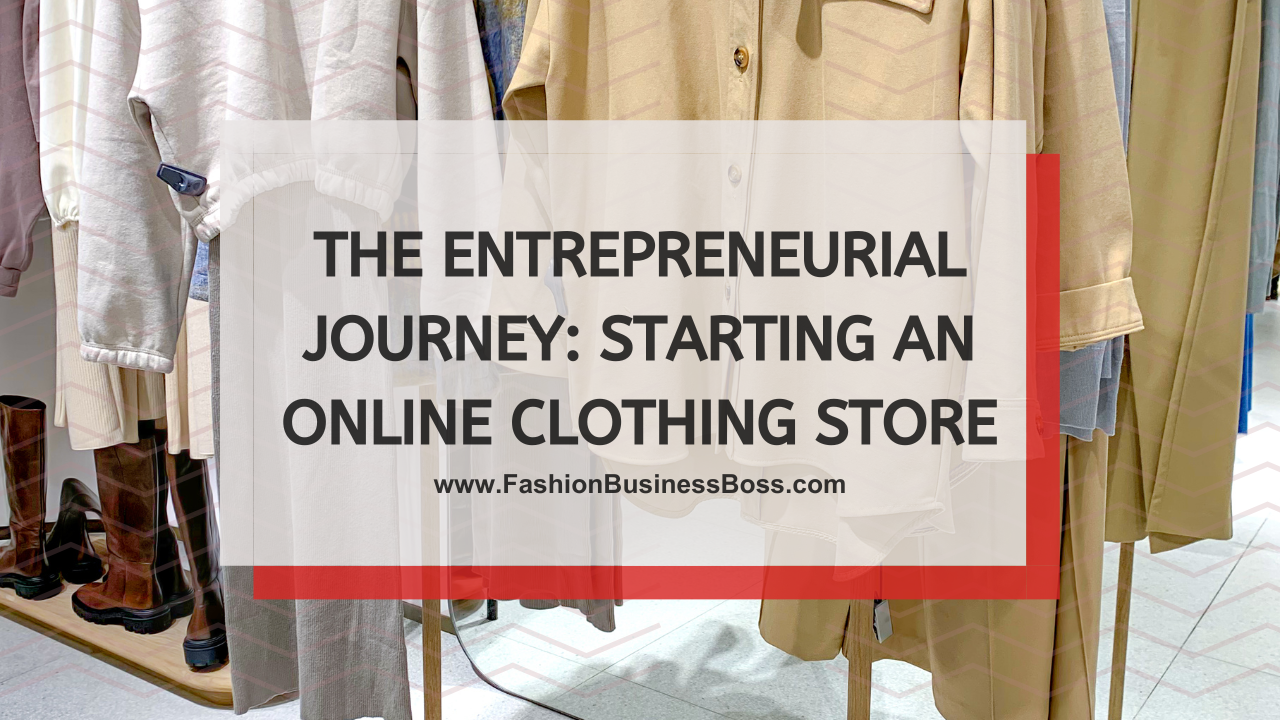The online clothing industry has seen explosive growth in recent years, and the opportunities for aspiring entrepreneurs to launch their own online clothing businesses are more abundant than ever. If you’re passionate about fashion and want to carve a niche for yourself in the e-commerce world,
To thrive in online clothing, choose quality products, craft a unique brand, and engage customers through social media. Prioritize customer service and reliable shipping. Dedication and detail matter most.
In this article, we will provide you with the essential steps and strategies to start and run an online clothing business.
Selecting the Right Products

First, identify your niche. Think about what type of clothing you want to sell. Will it be casual wear, sportswear, or something else? Knowing your niche helps you target the right audience.
Next, research your target market. Understand their preferences, needs, and purchasing behavior. This information will guide your product selection.
Now, find reliable suppliers or manufacturers. Look for ones that offer quality products at affordable prices. It’s crucial to maintain good relationships with your suppliers for a smooth operation.
Consider the seasonality of your products. Ensure you have a mix of items suitable for different seasons to maintain a consistent income.
Lastly, keep an eye on trends. Fashion evolves, so stay updated on what’s in demand. Add trendy items to your inventory to attract more customers.
Selecting the right products for your online clothing business involves niche identification, market research, supplier evaluation, seasonality consideration, and trend awareness. By following these steps diligently, you’ll set a strong foundation for your venture.
Read more about: Launching Your Dream: How to Start an Online Clothing Business with Zero Money
Crafting a Memorable Brand Identity
Creating a memorable brand identity is a critical step when embarking on your journey to start an online clothing business. This process involves several key elements that you should master to establish a lasting presence in the market.
First, define your brand’s unique selling proposition (USP). Your USP is what sets you apart from competitors. It could be your clothing’s quality, affordability, or a specific style that resonates with your target audience.
Next, develop a distinctive brand name and logo. These should reflect your brand’s essence and be easy to remember. Keep them simple and relevant to your niche.
Consistency is key in branding. Ensure that your brand’s messaging, visuals, and tone remain uniform across all platforms and communication channels. This consistency helps build recognition and trust.
Utilize social media and online platforms to engage with your audience. Share compelling stories and content related to your clothing line to create a sense of community and loyalty among your customers.
Lastly, continuously monitor and adapt your brand identity as needed. Market trends evolve, and customer preferences change, so staying flexible and responsive is essential for long-term stability.
Creating a User-Friendly Website
When embarking on the journey of starting an online clothing business, one crucial aspect is creating a user-friendly website. A well-designed website plays a pivotal role in attracting and retaining customers. Here’s a straightforward guide on how to achieve this.
Begin by selecting a reliable e-commerce platform, like Shopify or WooCommerce, that suits your needs and budget. These platforms offer user-friendly templates that simplify website creation.
Next, focus on an intuitive layout. Ensure that your website is easy to navigate. Arrange categories logically, so visitors can quickly find the clothing they’re interested in. Use clear headings and menus.
Optimize your website for mobile devices since many users shop on smartphones. A responsive design ensures that your site looks and functions well on various screen sizes.
Loading speed matters. Compress images and minimize unnecessary plugins to enhance page loading times. Slow websites can deter potential customers.
Security is paramount. Invest in SSL certificates to protect customer data. Display trust badges to reassure visitors about the safety of their transactions.
Lastly, create high-quality product images and descriptions. Use crisp, well-lit photos and provide detailed information to aid customers in making informed choices.
Sourcing and Managing Inventory
Finding Reliable Suppliers

When embarking on the journey to start an online clothing business, one critical aspect is finding reliable suppliers. The suppliers you choose can significantly impact the quality and availability of your products. Here’s a straightforward guide to help you in this important task.
Begin by conducting thorough research. Look for suppliers who specialize in the type of clothing you plan to sell. Consider factors such as their reputation, reliability, and track record in delivering consistent quality.
Contact multiple potential suppliers to gather information about their pricing, minimum order quantities, and lead times. Compare these details to find suppliers that align with your budget and inventory needs.
Seek recommendations from other entrepreneurs or industry associations. Their insights can provide valuable guidance in identifying reputable suppliers.
It’s crucial to establish open and clear communication with your chosen suppliers. Clearly convey your expectations and requirements. Regularly communicate to ensure a smooth and ongoing partnership.
Consider diversifying your sources. Relying on a single supplier can pose risks in case of unforeseen issues. Having backup suppliers can help mitigate disruptions.
Lastly, negotiate favorable terms with your suppliers. Discuss pricing, payment terms, and any potential discounts based on order volume.
Read more about: Launching Your Clothing Brand with Little to No Initial Capital: Creative Strategies and Practical Steps
Inventory Management Strategies
Managing inventory is a crucial aspect of launching an online clothing business. Effective inventory management ensures that you have the right products in stock, prevents overstocking or understocking, and helps you meet customer demand efficiently. Here’s a simple guide to help you master inventory management strategies.
Start by categorizing your clothing items. Group them by type, size, and season. This organization will make it easier to track and manage your inventory.
Set up an inventory tracking system. Whether you use spreadsheet software or an inventory management tool, accurately record all incoming and outgoing stock. Update it regularly to maintain real-time visibility.
Implement the first-in, first-out (FIFO) method. This means selling the oldest stock first to prevent items from becoming outdated or unsellable.
Consider dropshipping for some products. With dropshipping, you won’t need to hold physical inventory for certain items, reducing storage costs and the risk of overstocking.
Monitor sales trends and customer preferences. Keep an eye on which items are selling well and which are not. Adjust your inventory accordingly to meet customer demand.
Regularly conduct physical inventory audits to reconcile discrepancies between your records and actual stock levels. This helps prevent stockouts or overordering.
Ensuring Quality Control
Maintaining quality control is a critical aspect of launching an online clothing business. It ensures that the clothing you offer meets high standards, which, in turn, fosters customer satisfaction and trust. Here is a clear and straightforward guide to help you master quality control.
Start by defining your quality standards. Clearly outline what constitutes a high-quality product for your business. This could include factors like fabric quality, stitching, and overall durability.
Select reliable suppliers and manufacturers who consistently produce clothing that meets your established quality standards. Thoroughly vet potential partners to ensure they share your commitment to quality.
Establish clear quality control processes. Implement checks and inspections at various stages of production, from fabric sourcing to final product assembly. This helps catch any defects or issues early on.
Train your team, if applicable, to understand and execute quality control procedures effectively. Make sure they are aware of your quality standards and the importance of maintaining them.
Regularly inspect samples of your clothing items before they are made available for sale. This ongoing monitoring helps identify and rectify any quality issues promptly.
Listen to customer feedback. Pay attention to their comments and concerns regarding product quality. Use this feedback to make improvements and adjustments to your quality control processes.
Creating Engaging Content

Creating engaging content is a fundamental aspect of launching an online clothing business. It plays a crucial role in attracting and retaining customers, ultimately contributing to the growth of your venture. Here is a clear and straightforward guide to help you master the art of creating compelling content.
Start by understanding your target audience. Get to know their preferences, interests, and pain points. This insight will guide you in creating content that resonates with them.
Develop a content calendar to plan what and when you’ll publish. Consistency is key to keeping your audience engaged. Include a variety of content types, such as blog posts, social media updates, and videos.
Focus on providing value. Your content should offer useful information, entertainment, or inspiration to your audience. Solve their problems or address their needs through your content.
Use visuals effectively. High-quality images and videos showcasing your clothing can captivate your audience. Ensure that they are well-lit, clear, and appealing.
Incorporate storytelling. Share your brand’s story, mission, and values. Connect with your audience on a personal level to build trust and loyalty.
Interact with your audience through comments, messages, and social media. Respond to their inquiries and feedback promptly to foster engagement and a sense of community.
Read more about: Instagram’s Fashion Frontier: How to Start a Clothing Brand on Instagram
Building Backlinks and Domain Authority
Starting an online clothing business can be a fulfilling journey. First, focus on your website’s foundation. Choose a memorable domain name, something related to your brand. Ensure your website is user-friendly and loads quickly.
Now, let’s talk about building backlinks and domain authority. Think of backlinks as references from other websites to yours. They act as trust signals to search engines like Google. To get backlinks, create high-quality content on your blog. This could be fashion tips, styling guides, or industry insights. People are more likely to link to valuable content.
Collaborate with influencers in the fashion niche. When they mention your brand, it often includes a link back to your site. Networking within your industry can also lead to backlink opportunities.
Domain authority measures your website’s credibility. It increases as you acquire quality backlinks. Be patient; this process takes time. Stay consistent with your content, and remember, it’s not about quantity but quality of links.
Leveraging Instagram and Facebook
Starting an online clothing business can be a fulfilling endeavor. To enhance your venture, it’s important to leverage social media platforms like Instagram and Facebook.
Begin by creating appealing profiles for your business on both Instagram and Facebook. Use eye-catching images of your clothing products and provide clear and concise descriptions. Make sure your brand identity shines through in your profiles, including your logo, brand colors, and a brief bio.
Regularly post engaging content that showcases your clothing items. Use relevant hashtags to increase visibility, but don’t overdo it. Consistency is key; maintain a regular posting schedule to keep your audience engaged.
Interact with your followers by responding to comments and messages promptly. Building a loyal community can boost your business. Consider running targeted ads on Facebook and Instagram to reach a broader audience.
Collaborate with influencers in the fashion niche who align with your brand. Their endorsements can expand your reach and credibility.
Engaging with Customers on Social Media
Commencing an online clothing business is an endeavor with potential rewards. One vital aspect is engaging with customers effectively on social media platforms.
First, establish your presence on social media platforms such as Instagram, Facebook, and Twitter. Create profiles that reflect your brand identity through visuals like your logo and brand colors. Keep your bio concise yet informative.
Consistency in posting is crucial. Share compelling content showcasing your clothing items. Utilize relevant hashtags to augment your content’s discoverability, but avoid excessive use. Regularity in your posting schedule maintains audience engagement.
Interact actively with your followers. Respond promptly to comments and messages, fostering a sense of community. Customer feedback, whether positive or constructive, should be acknowledged and addressed professionally.
Consider running targeted advertising campaigns on social media to widen your reach. Collaborating with influencers in the fashion domain can amplify your brand’s visibility and credibility.
Providing Excellent Customer Support

Embarking on an online clothing business is a promising endeavor. A crucial component of this journey is ensuring excellent customer support.
Begin by setting up accessible communication channels, such as email and a contact form on your website. Respond to customer inquiries promptly and professionally, addressing their questions and concerns clearly.
Transparency is key. Be upfront about your policies, including shipping, returns, and any potential issues. Providing detailed product descriptions and sizing information on your website can also minimize customer confusion and inquiries.
In cases of customer issues or complaints, remain calm and empathetic. Listen to their concerns and work towards finding a reasonable solution. Resolve problems in a fair and timely manner to maintain customer trust.
Collect and analyze feedback from customers to identify areas for improvement. Use this valuable input to enhance your products and services continually.
Read more about: Mastering the Art of Fashion Entrepreneurship: Selling Your Clothing Brand
Choosing the Right Shipping Partners
Commencing an online clothing business holds significant potential. One pivotal aspect to consider is selecting the appropriate shipping partners to ensure a seamless customer experience.
Begin by researching and evaluating various shipping carriers or services available in your area. Consider factors like shipping speed, reliability, and cost. Look for carriers that align with your business’s needs and budget.
Once you’ve identified potential partners, establish clear shipping policies on your website. Specify shipping rates, delivery times, and any potential restrictions. Transparency is essential to manage customer expectations.
Efficiency matters. Streamline your packaging process to ensure orders are prepared and shipped promptly. Implement a reliable tracking system that allows customers to monitor their shipments.
Customer satisfaction is closely tied to shipping. Address any shipping issues or delays promptly and professionally. A responsive customer support team can assist in resolving shipping-related concerns.
Regularly assess your chosen shipping partners’ performance and consider feedback from customers. If issues persist, explore alternative options to maintain a positive customer experience.
Conclusion
Starting and running an online clothing business requires careful planning, creativity, and dedication. By understanding the e-commerce landscape, focusing on a specific niche, and employing effective marketing strategies, you can establish a thriving online clothing store. Embrace innovation, prioritize customer satisfaction, and stay adaptable to the ever-changing fashion industry to achieve long-term growth.
Frequently Asked Questions

How much capital is needed to start an online clothing business?
Starting an online clothing business can vary in costs, but it’s possible to launch with a modest budget by carefully managing expenses and starting small.
Do I need to be a fashion expert to start an online clothing business?
While having a passion for fashion can be beneficial, it’s not a requirement. Research and understanding your target audience’s preferences are more critical.
What marketing channels are most effective for online clothing businesses?
Social media marketing, influencer partnerships, and email marketing are some of the most effective channels for promoting online clothing businesses.
To learn more about starting your own clothing business, check out my startup documents here.
The information provided by FashionBusinessBoss.com (“The Site”) is for general informational purposes only. All information on the Site is provided in good faith, however, we make no representation or warranty of any kind, express or implied, regarding the accuracy, adequacy, validity, reliability, availability or completeness of any information on the Site. Under no circumstance shall we have any liability to you for any loss or damage of any kind incurred as a result of the use of the Site or Reliance on any information provided on the Site. Your use of the Site and your reliance on any information on the Site is solely at your own risk. This blog post is for educational purposes only and does not constitute legal advice. Please consult a legal expert to address your specific needs. Terms and Conditions. (https://fashionbusinessboss.com/terms-and-conditions/)

Meet Shawn Chun: Entrepreneur and Fashion Business Fan.
I’m a happy individual who happens to be an entrepreneur. I have owned several types of businesses in my life from a coffee shop to an import and export business to an online review business plus a few more and now I create online resources for those interested in starting new ventures. It’s demanding work but I love it. I do it for those passionate about their business and their goals. That’s why when I meet a designer or boutique owner at a craft fair, farmers market, retail location or anywhere else I see myself. I know how hard the struggle is to retain clients, find good employees and keep the business growing all while trying to stay competitive.
That’s why I created Fashion Business Boss: I want to help fashion business owners like you build a thriving business that brings you endless joy and supports your ideal lifestyle.

